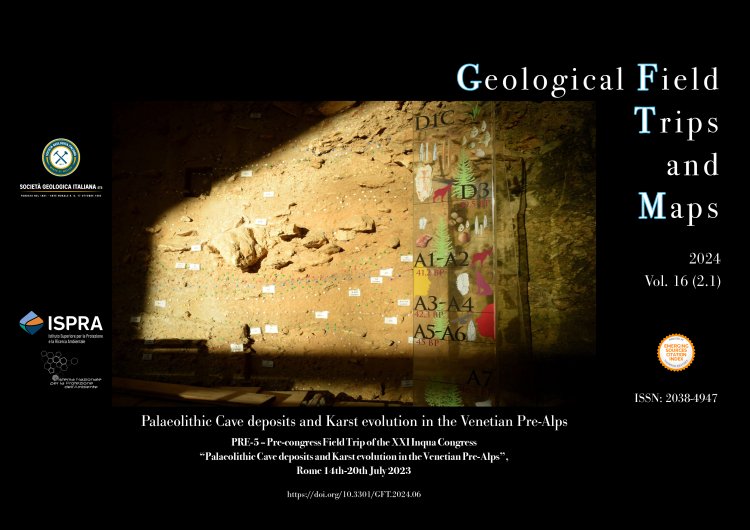
Volume 16 (2.1)/2024
Palaeolithic Cave deposits and Karst evolution in the Venetian Pre-Alps
PRE-5 – Pre-congress Field Trip of the XXI Inqua Congress "Palaeolithic Cave deposits and Karst evolution in the Venetian Pre-Alps", Rome 14th-20th July 2023
DOI: https://doi.org/10.3301/GFT.2024.06 - Pages: 1-40
Marco Peresani1,2 & Ugo Sauro3
1Department of Humanities, Section of Prehistoric and Anthropological Sciences, University of Ferrara, Corso Ercole I d'Este, 32, 44100 Ferrara, Italy.
2Institute of Environmental Geology and Geoengineering, National Council of Research, Piazza della Scienza 1, 20126 Milano, Italy.
2Lessinia, Man and environment Ethnographic Museum, Via Spiazzi 4, 37021 Bosco Chiesanuova, Italy.
Corresponding author e-mail: marco.peresani@unife.it
2Institute of Environmental Geology and Geoengineering, National Council of Research, Piazza della Scienza 1, 20126 Milano, Italy.
2Lessinia, Man and environment Ethnographic Museum, Via Spiazzi 4, 37021 Bosco Chiesanuova, Italy.
Corresponding author e-mail: marco.peresani@unife.it
Abstract
This excursion delves into the themes of human evolution, Palaeolithic caves, and karst landscapes, providing participants with a unique opportunity to explore the Monti Lessini, the Monti Berici, and two Palaeolithic sites in the Eastern Italian Pre-Alps and Alpine foreland. The Monti Lessini are characterised by a unique physical landscape shaped by tectonic evolution and a range of geomorphological processes including fluvial, karstic, glacial, and periglacial dynamics. This pre-alpine zone boasts an abundance of natural archives nestled within karst cavities, serving as invaluable resources for research into the human-ecological dynamics of Neanderthals and early Homo sapiens.
At Grotta di Fumane, the deposits represent evidence of paramount significance for understanding the subsistence and spirituality of ancient humanity that thrived in this region of southern Europe for over 50,000 years. The second part of the excursion is dedicated to showcasing the fluviokarstic landscape of the Monti Berici, characterised by a plateau featuring varied topography, including peaks, sinkholes, palaeosols and caves like Grotta San Bernardino. This site is of particular significance as it preserves a Middle and Late Pleistocene stratigraphy, which records a series of climatic cycles and provides evidence of Neanderthal use of the cave and surrounding landscape resources across varying ecologies.
Keywords
